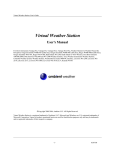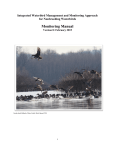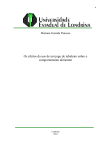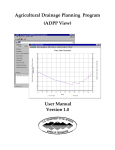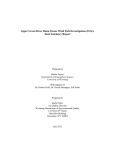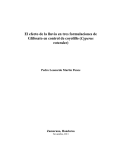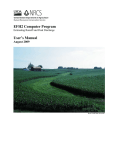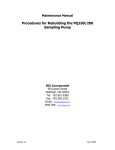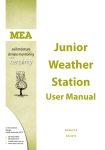Download MU Extension Crop Water User Manual
Transcript
AGRICULTURAL USER MANUAL PUBLISHED BY UNIVERSITY OF MISSOURI EXTENSION Crop Water Use Program for Irrigation Divisions of Plant Sciences, Applied Social Sciences, Food Sciences and Bioengineering, and Soil, Environmental, and Atmospheric Sciences. Water is an important factor affecting crop yields. The University of Missouri Extension Service developed an on-line program (app) to help farmers produce higher crop yields by improving irrigation management. There is no charge to farmers. This bulletin gives information about the Crop Water Use (CWU) application and explains how to set up fields to track soil moisture. How Does The Application Work? The application estimates crop water use from weather data. An equation for calculating evaporation from soil and plants (called evapotranspiration, ET) is used. The application also calculates daily soil water deficit balances for each field. Reports include indexes to help farmers determine when to irrigate. Crop Water Use. The University of MO Extension automatically downloads data each day from a mesonet of agricultural weather stations located across Missouri. ET is calculated from solar radiation, temperature, humidity, and wind. CWU uses the Standardized short crop PenmanMonteith Evapotranspiration (ETo) equation which was developed by a task committee of the American Society of Civil Engineers. ETo is the amount of combined water lost from a reference crop (grass) and soil evaporation. Authors Gene Stevens, Zach Straatmann, Joe Henggeler, and Andrea Phillips Jones are located at the Fisher Delta Research Center in Portageville, Missouri. John Travlos, Stephen Martin, Pat Guinan, and Ray Massey are located on the University of Missouri campus in Columbia, Missouri. ETo is multiplied by a crop coefficient, which is specific for the crop and growth stage. The crop coefficients, except for rice, come from UN Food and Ag Organization publication FAO-56. Beginning at planting, growth stages are predicted from heat units for corn, rice, and cotton. Calendar days are used for soybean. This information is used to estimate daily crop water use (ETc). Soil Water Balance. Daily soil water deficit is reported similar to a checkbook registry which tallies rainfall and irrigation as deposits and ETc as withdrawals. The soil water deficit becomes more negative in periods of low rainfall. When the soil profile is full (field capacity), the deficit balance is 0. As water is extracted, the balance becomes negative. Acknowledgements. Funds for field research to validate this app were provided by Cotton Incorporated, Howard G. Buffett Foundation, and United States Department of Agriculture- Agricultural Research Service. 1 Getting Started Enrollment. In a browser address box, type this address to sign up and click “Sign Up”. agebb.missouri.edu/horizonpoint/cropwater. php. Read the Terms of Use. If you approve, click “I agree” (Figure 1). Enter information in the boxes (Figure 2). Name, phone number are optional. Email address, User Name, password are required. Then on the third screen, you will have the option to either launch the application now and bookmark the link or request the address by email (Figure 3). Figure 3. Launch App or Request E-Mail Link. If you request email link, an address with 32 random numbers and letters will be generated. Only share your unique address with people that you trust. You can copy (Ctl C) and paste (Ctl V) the address of the link to your computer and mobile phone. This will save you time not having to type in a password every day to check your fields. Figure 1. Introduction screen for CWU app. The Crop Water Use App requires daily weather from the Missouri weather station mesonet to function. Currently, the program only works when you have internet access by WiFi or a cellular data connection. Before beginning the set up process, it is best to write down on paper the names of all your fields with their latitude and longitude, dominant soil texture, and planned crop. Latitude and longitude are used to estimate rainfall from the National Weather Service. Find the fields location on Google Earth or go to each field and copy and paste the locations from an app such Where Am I At? (iTunes app store). Example: Lat: 36.4151365, Long: 89.7010119. CWU uses positive decimal degrees. Do not use minutes and seconds. Figure 2. Enter information and click submit. 2 Main Screen Click on the bookmarked website address for your farm in browser. The first screen that will appear in the app is Main (Figure 4). This is the starting place to add new fields, setting the soil and crop information, monitoring daily soil moisture, logging rainfall and irrigation amounts, and requesting field reports. The location cannot be changed now but it is easy to delete and re-enter a field. Select the dominant soil texture for the field (Figure 6). This is used to estimate available soil water holding capacity. For more information about soils on your farm, check the NRCS Soil Survey site: http://websoilsurvey.sc.egov.usda.gov/Ap p/HomePage.htm. Figure 5. Enter latitude and longitude of field Figure 4. The main menu screen. Field Setup Now, click on Add Field in the third row. In the next screen, click on the top boxes and enter the field name and decimal degrees for north latitude and west longitude which are both positive real numbers (Figure 5). If they enter west longitude as a negative number the program will correct it without error. Be sure the correct GPS location for the field is entered before clicking Submit. The title at the top of the page will change to Edit Field. Figure 6. Select soil texture for each field. 3 Although the lat/long is locked in, soil texture for a field can be changed later to a finer or coarser texture if needed. USDA and can be found at this site: http://www.nrcs.usda.gov/wps/portal/nrcs/ detail/mt/newsroom/?cid=nrcs144p2%200 56492 Click on Submit and Back to Main Menu. The next step is setting up crop information. In the Main Menu, click Setup Soils and Crops (fourth row, second column). Then scroll to the field name and click on na under Crops in the second column. Figure 8. Select the most common rate of water that you will apply with the irrigation system. Figure 7. Field/Crop information page for entering field and crop information. Select the planted crop in the field. The default planting date is 12/31 (Figure 7). Important: If crop and planting date are not known yet, do not guess. Skip these boxes and come back later. Other boxes on this page can be entered even if crop and planting date are not known. Click Submit to save the information. The next box on the page is Soil water deficit on planting date (Figure 8). The soil water balance works on the same principle as a checkbook registry. Like a checkbook, CWU needs a beginning balance. Unless spring rainfall has been usually low, leave the default value on zero (field capacity) for initial soil moisture. A field method for estimating soil moisture by hand was developed by Fill in the rest of the boxes on this page. The effective root depth for most crops in Missouri is in the range of 18 to 24 inches. If the soil has a restrictive layer from compaction, enter a shallower depth. During the season, the rooting depth can be modified. Select the irrigation method and default rate of water application. Leave the allowable field water depletion at the default 50% unless you want to be more liberal with making irrigation applications. Then click “Yes” on NWS Rainfall if you want the program to automatically enter the estimated rainfall amounts based on GPS locations of the field. If you click yes, during the season, you will also have the option to substitute your rain gauge measurements for individual rainfall events or completely turn this feature off. Click “No” to never use NWS rainfall estimates. Now, repeat the Setup steps for other fields until all are entered in the app. 4 Monitoring Daily Soil Water in Fields In the Main menu (top row), click Field Status or Field Summary to check daily water status in each field. Field Status shows estimates for each field individually for the current day (Figure 9) and Field Summary shows projected dryness indexes for all your fields for today and the next week assuming no rainfall occurs (Figure 10). for today and the next week. To see the most columns tilt the phone to landscape position. Figure 10. Main menu screen for checking soil water dryness indexes for the next week. As the crop grows and periods of low rainfall occur, the values in the H2O deficit inches will become more negative. Figure 9. Field Status screen for checking daily soil water deficits in individual fields. To navigate between fields in Field Status, swipe your finger right to left or left to right across the bottom of the screen. As the season progress, your fields in Field Status will be sorted each day from driest to wettest soils. The Dryness Index warns you when the soil water deficit is coming close to the Management Allowed Depletion (MAD) level of the field which is the recommended trigger for irrigation. The symbols (*,**,***, and XXX) represent 70%, 80%, 90%, and 100% of MAD, respectively. The value showing “Left to trigger” is the percentage remaining relative to MAD before the reserve water is used. The text will change from green to yellow then red as the soil dries. In Field Summary, today’s soil water deficit is shown for each field with the dryness index Soils have different water storage capacities, so no single soil water deficit value is acceptable across all soils. For example, crops growing on sandy soil stress for water faster than crops on silt loam soil. Factors used for calculating MAD are soil texture, crop rooting depth, and allowable depletion. Soil texture is used to estimate available water holding capacity (AWHC). The formula for MAD is AWHC x Root Depth x Percent Allowable Depletion. More details about water credits and debits is found in the Field Detail screen. You can find this screen from the Main menu or clicking on a row in the Field Summary table. This screen shows the daily values for crop ET, inches of rainfall and soil water deficit for the last week (Figure 11). To view more days, click on “All Days” at the bottom of the page. The second row of boxes will be for entering rainfall and irrigation amounts after the fields have been setup. 5 The NWS amount will still be displayed, but it will not be used by CWU. Figure 11. Detail page with water debits and credits for single field in past seven days. When soil water deficit values equals 70% of the MAD level, the Dryness Index column will display a single red asterisk. Without rain or irrigation more asterisks will appear in the following days. Avoid letting the index become red with XXX for several days. Once a field soil becomes dry, crop yield is lost. When the dryness index does not match soil moisture sensors or visual crop water stress, fine-tune the field setup by adjusting the rooting depth or allowed depletion percentage. Entering Rainfall and Irrigations Two options are available for entering rainfall and irrigation events. Click on the water faucet symbol (Figure 10, first column) in a field row of Field Summary to navigate to the Add/Edit Precipitation and Irrigation page (Figure 12). If “Yes” was selected for NWS rainfall in setup, the third column displayed will be “NWS Precip”. To override NWS for a specific day, enter the correct value in the blue column labeled, “Field Precip”. The rainfall amounts will be underlined indicating the CWU is using the new value for that day. Figure 12. Page to edit precipitation (rain) and irrigation for amounts field. To enter rainfall amounts in the program click on a cell in the light blue column (4th) corresponding the date that water was applied. Likewise for irrigation, click on the green column (far right). The irrigation default rate that was entered in the setup will appear (Figure 13). If needed, it can be modified before clicking Submit. When other fields receive the same amount of irrigation, click the check boxes beside their names at the bottom of the page. Unfortunately, the 24 hour period for rainfall at the National Weather Service is not midnight to midnight. It is mid-morning to mid-morning so a late afternoon rainfall still will not been posted in the app at 6 am the next morning. If you know how much it rained in your rain gauge, enter it rather than wait for an NWS update. When NWS shows a rainfall amount but none actually occurred, enter 0 in the blue Field Precip column. When other fields on the farm also received the same amount of rainfall (or none), click the check boxes beside their names at the bottom of the page. 6 becomes zero. In this case, a small inaccuracy is not critical in the app. Figure 15. Rainfall tracked by National Weather Service radar. Figure 13. Irrigation input page for entering irrigation events for fields. To access a report for printing go to Report (3rd row, right column) in the Main menu (Figure 4). Select the field to print and click “Print” (Figure 14). If you clicked “Yes” in the field setup for NWS rainfall, compare your rain gauge measurement to the rainfall amount in the blue column, remembering amounts are not posted at midnight. If it does not agree closely, click on the column to override the NWS amount. Balance the value of exactness relative to the time required to enter rain amounts from gauges. The daily reference ET values used in the CWU app is collected from the MU closest electronic water station to your field. The main variable in the Penman-Monteith equation is solar radiation which is more consistent across a region than rainfall. Terms of Use Figure 14. Example field reports showing daily rainfall, irrigations, and ET crop. NWS Rainfall and ET Accuracy The greatest differences between NWS rainfall estimates and field rain gauge measurements usually occurs during isolated storms (Figure 15). The NWS grid is too coarse to accurately estimate rainfall in small thunderstorms. When heavy rainfall occurs on a field, the soil water deficit balance reaches field capacity and soil water deficit The Crop Water Use Application is a weather based prediction model designed to aid farmers with irrigation management. It is not intended to be a substitute for scouting fields. Always inspect soil and crop conditions in each field before deciding whether or not to irrigate. Under no circumstances including negligence, shall the University of Missouri, or its Board of Curators, officers, employees or agents, be liable for any incidental, indirect, special or consequential damages (including damages for loss of business profits, business interruption, and the like) arising out of the use, misuse or inability to use this application or any related documentation. Information is provided by the University of Missouri Extension Commercial Agriculture Automated Weather Station Network. The Commercial Agriculture Automated Weather Station Network and the University of Missouri give no warranty as to the accuracy, reliability, utility, or completeness of this information. While we use care to provide accurate weather/climatic information, errors may occur because of equipment or other failure. Users of this weather/climate data do so at their own risk, and are advised to use independent judgment as to whether to verify the data presented. The University of Missouri expressly disclaims all warranties, express and implied, including, but not limited to, the implied warranty of merchantability and fitness for a particular purpose. 7







